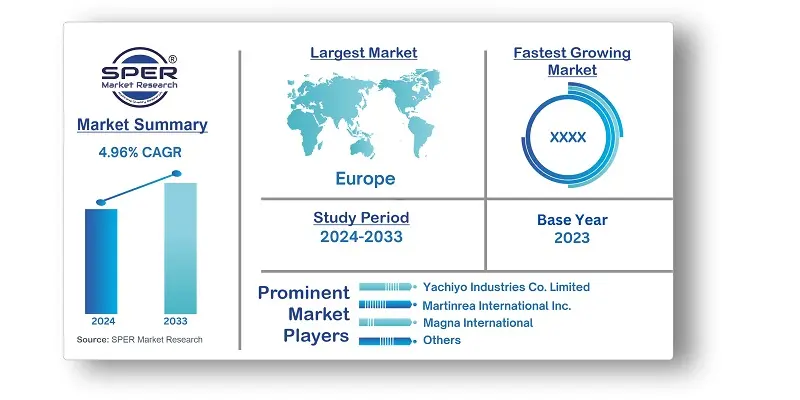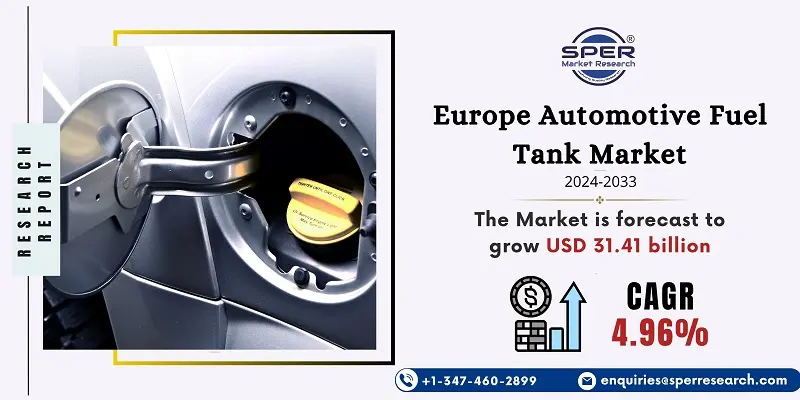
Europe Automotive Fuel Tank Market Growth, Size, Trends, Demand, Revenue and Future Outlook
Europe Automotive Fuel Tank Market Size- By Material Types, By Capacities, By Vehicle Types, By Distribution Channels- Regional outlook, Competitive Strategies and Segment Forecast to 2033
| Published: Aug-2024 | Report ID: AMIN24184 | Pages: 1 - 156 | Formats*: |
| Category : Automotive & Transportation | |||
- October 2020; Plastic Omnium and ELRINGKLINGER accomplice in power module innovation to speed up the advancement of hydrogen portability. They will make EKPO Energy unit Innovations, a joint endeavour committed to power module stack improvement, creation, and commercialization.


| Report Metric | Details |
| Market size available for years | 2020-2033 |
| Base year considered | 2023 |
| Forecast period | 2024-2033 |
| Segments covered | By Material Types, By Capacities, By Vehicle Types, By Distribution Channels |
| Regions covered | Germany, France, U.K., Italy, Spain, Russia, Turkey, Belgium, Denmark, Netherlands, Switzerland, Sweden, Poland, Norway, Finland, and Rest of Europe. |
| Companies Covered | Continental, Kautex Textron, Lyondell Basell, Magna International, Martinrea International Inc., Plastic Omnium, TI Automotive, Unipres Corporation, Yachiyo Industries Co. Limited, and Yapp Automotive. |
- OEMs (Original Equipment Manufacturers)
- Aftermarket Suppliers
- Fleet Operators
- Automobile Manufacturers
- Vehicle Owners
- Fuel Tank Repair and Replacement Service Providers
| By Material Types: |
|
| By Capacities: |
|
| By Vehicle types: |
|
| By Distribution Channel: |
|
- Europe Automotive Fuel Tank Market Size (FY’2024-FY’2033)
- Overview of Europe Automotive Fuel Tank Market
- Segmentation of Europe Automotive Fuel Tank Market by Material Types (Plastic, Aluminium, Steel)
- Segmentation of Europe Automotive Fuel Tank Market by Capacities (Less Than 45 Liter, 45 - 70 Liter, Above 70 Liter)
- Segmentation of Europe Automotive Fuel Tank Market by Vehicle Types (D Passenger Vehicles, LCVs, HCVs)
- Segmentation of Europe Automotive Fuel Tank Market by Distribution Channel (OEM, Aftermarket)
- Statistical Snap of Europe Automotive Fuel Tank Market
- Expansion Analysis of Europe Automotive Fuel Tank Market
- Problems and Obstacles in Europe Automotive Fuel Tank Market
- Competitive Landscape in the Europe Automotive Fuel Tank Market
- Impact of COVID-19 and Demonetization on Europe Automotive Fuel Tank Market
- Details on Current Investment in Europe Automotive Fuel Tank Market
- Competitive Analysis of Europe Automotive Fuel Tank Market
- Prominent Players in the Europe Automotive Fuel Tank Market
- SWOT Analysis of Europe Automotive Fuel Tank Market
- Europe Automotive Fuel Tank Market Future Outlook and Projections (FY’2024-FY’2033)
- Recommendations from Analyst
1.1. Scope of the report1.2. Market segment analysis
2.1. Research data Material Types
2.1.1. Secondary Data2.1.2. Primary Data2.1.3. SPER’s internal database2.1.4. Premium insight from KOL’s
2.2. Market size estimation
2.2.1. Top-down and Bottom-up approach
2.3. Data triangulation
4.1. Driver, Restraint, Opportunity, and Challenges analysis
4.1.1. Drivers4.1.2. Restraints4.1.3. Opportunities4.1.4. Challenges
4.2. COVID-19 Impacts of the Europe Automotive Fuel Tank Market
5.1. SWOT Analysis
5.1.1. Strengths5.1.2. Weaknesses5.1.3. Opportunities5.1.4. Threats
5.2. PESTEL Analysis
5.2.1. Political Landscape5.2.2. Economic Landscape5.2.3. Social Landscape5.2.4. Technological Landscape5.2.5. Environmental Landscape5.2.6. Legal Landscape
5.3. PORTER’s Five Forces
5.3.1. Bargaining power of suppliers5.3.2. Bargaining power of buyers5.3.3. Threat of Substitute5.3.4. Threat of new entrant5.3.5. Competitive rivalry
5.4. Heat Map Analysis
6.1. Europe Automotive Fuel Tank Market Manufacturing Base Distribution, Sales Area, Product Type6.2. Mergers & Acquisitions, Partnerships, Product Launch, and Collaboration in Europe Automotive Fuel Tank Market
7.1. Europe Automotive Fuel Tank Market Size, Share and Forecast, By Material Types, 2020-20267.2. Europe Automotive Fuel Tank Market Size, Share and Forecast, By Material Types, 2027-20337.3. Plastic7.4. Aluminium7.5. Steel
8.1. Europe Automotive Fuel Tank Market Size, Share and Forecast, By Capacities, 2020-20268.2. Europe Automotive Fuel Tank Market Size, Share and Forecast, By Capacities, 2027-20338.3. Less Than 45 Liter8.4. 45 - 70 Liter8.5. Above 70 Liter
9.1. Europe Automotive Fuel Tank Market Size, Share and Forecast, By Vehicle types, 2020-20269.2. Europe Automotive Fuel Tank Market Size, Share and Forecast, By Vehicle types, 2027-20339.3. Passenger Vehicles9.4. LCVs9.5. HCVs
10.1. Europe Automotive Fuel Tank Market Size, Share and Forecast, By Distribution Channel, 2020-202610.2. Europe Automotive Fuel Tank Market Size, Share and Forecast, By Distribution Channel, 2027-203310.3. OEM10.4. Aftermarket
11.1. Europe Automotive Fuel Tank Market Size and Market Share
12.1. Europe Automotive Fuel Tank Market Size and Market Share By Region (2020-2026)12.2. Europe Automotive Fuel Tank Market Size and Market Share By Region (2027-2033)12.3. Germany12.4. France12.5. U.K.12.6. Italy12.7. Spain12.8. Russia12.9. Turkey12.10. Belgium12.11. Denmark12.12. Netherlands12.13. Switzerland12.14. Sweden12.15. Poland12.16. Norway12.17. Finland12.18. Rest of Europe
13.1. Continental
13.1.1. Company details13.1.2. Financial outlook13.1.3. Product summary13.1.4. Recent developments
13.2. Kautex Textron
13.2.1. Company details13.2.2. Financial outlook13.2.3. Product summary13.2.4. Recent developments
13.3. Lyondell Basell
13.3.1. Company details13.3.2. Financial outlook13.3.3. Product summary13.3.4. Recent developments
13.4. Magna International
13.4.1. Company details13.4.2. Financial outlook13.4.3. Product summary13.4.4. Recent developments
13.5. Martinrea International Inc.
13.5.1. Company details13.5.2. Financial outlook13.5.3. Product summary13.5.4. Recent developments
13.6. Plastic Omnium
13.6.1. Company details13.6.2. Financial outlook13.6.3. Product summary13.6.4. Recent developments
13.7. TI Automotive
13.7.1. Company details13.7.2. Financial outlook13.7.3. Product summary13.7.4. Recent developments
13.8. Unipres Corporation
13.8.1. Company details13.8.2. Financial outlook13.8.3. Product summary13.8.4. Recent developments
13.9. Yachiyo Industries Co. Limited
13.9.1. Company details13.9.2. Financial outlook13.9.3. Product summary13.9.4. Recent developments
13.10. Yapp Automotive
13.10.1. Company details13.10.2. Financial outlook13.10.3. Product summary13.10.4. Recent developments
SPER Market Research’s methodology uses great emphasis on primary research to ensure that the market intelligence insights are up to date, reliable and accurate. Primary interviews are done with players involved in each phase of a supply chain to analyze the market forecasting. The secondary research method is used to help you fully understand how the future markets and the spending patterns look likes.
The report is based on in-depth qualitative and quantitative analysis of the Product Market. The quantitative analysis involves the application of various projection and sampling techniques. The qualitative analysis involves primary interviews, surveys, and vendor briefings. The data gathered as a result of these processes are validated through experts opinion. Our research methodology entails an ideal mixture of primary and secondary initiatives.



Frequently Asked Questions About This Report
PLACE AN ORDER
Year End Discount
Sample Report
Pre-Purchase Inquiry
NEED CUSTOMIZATION?
Request CustomizationCALL OR EMAIL US
100% Secure Payment






Related Reports
Our Global Clients
Our data-driven insights have influenced the strategy of 200+ reputed companies across the globe.




















